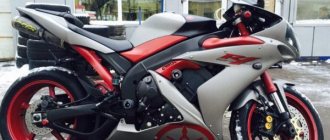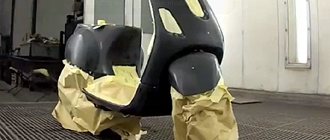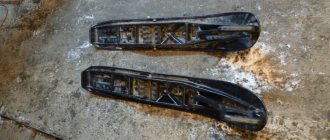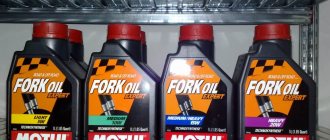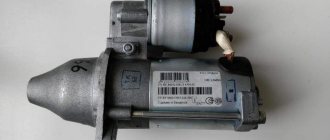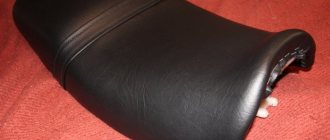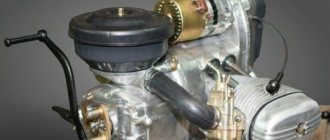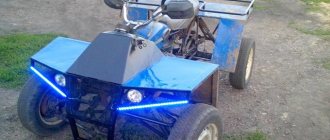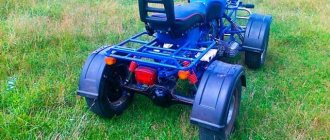Prices
Clients of the Pm-moto service center are guaranteed an affordable cost for painting a motorcycle with high quality of work performed. This service is periodically required by all motorcycle owners, since over time the paint fades, loses its shine, and small chips and cracks appear on the coating, which significantly spoil the appearance of the bike. In addition, defects in the paintwork lead to the destruction of parts under the influence of unfavorable external factors.
Painting a motorcycle is a rather complex technological process with a lot of subtleties, so it can only be entrusted to highly qualified specialists. Our technicians have many years of experience in the field of motorcycle maintenance and use the most modern technologies and equipment.
The range of services of the Pm-moto service center includes both local and complete painting of motorcycles in Moscow. We guarantee accurate selection of coating color, compliance with all stages of painting and completion of work in the shortest possible time. Customers can be confident in the reliability of the new paint coating, because it has a long service life, during which it does not lose its properties.
Exclusive motorcycle painting is also available at Pm-moto. Depending on the client’s wishes, both classic and creative solutions (luminescent, fluorescent, chameleon paints, etc.) can be used during work. If total painting is not required, we can apply coating (including airbrushing) to:
- engine;
- plastic parts;
- frame;
- tank;
- other parts of the motorcycle.
A wide selection of designs and colors will allow you to choose an exclusive color option for your bike to give it individuality.
Preparing a motorcycle for painting
The key to high quality painting work is the professional preparation of the motorcycle for painting. Only proper surface treatment before applying paint and varnish will guarantee its durability and aesthetic appearance.
Our service specialists have modern painting equipment and consumables of the highest quality at their disposal. They allow you to thoroughly prepare the work surface for painting, ensuring the necessary adhesion and an even layer of coating without visible boundaries. After the work is completed, the motorcycle is dried in a special chamber.
Among the advantages of our service center are not only good craftsmen and a modern material and technical base, but also affordable prices for painting a motorcycle. To sign up for this procedure, call our managers or fill out a special form on the website.
Choice of paint and primer
Let's start with choosing the right paints and varnishes. First of all, we buy primer of the GF-021 or FL-03K brands; they are considered one of the best for our business, since they do not react with the main coating and have good adhesion. Next - paint, there is a huge variety of it, but we choose mainly from three:
- Nitro-enamel is the most popular option. It has a low price, dries quickly, and has a huge selection of shades. These are the main advantages of the material. Among the shortcomings is a weak shine, which in general is not so important. More unpleasant aspects are low resistance to chemical materials and poor resistance to mechanical stress. Seasonal option - painted, left for the season, the paint was washed off by gasoline on the tank, damaged by oil drops or flying sand while moving. In winter, I disassembled the motorcycle and painted the parts again.
- Alkyd paints. A more practical option that holds chemical solvents tightly and is resistant to mechanical damage. Alas, you have to pay for such advantages in rubles, and alkyd paints cannot offer a special variety of colors. But the paint is easy to use, so applying it in a garage environment is a piece of cake.
- Acrylic paints. An intermediate option that has mechanical resistance, an excellent range of colors, is easy to apply, but also easily washed off with gasoline. So this paint can be used to paint almost all parts except the tank. If you drop gasoline, the color will immediately change to a duller shade.
As a result, the choice is always yours and it is based on how often you are willing to disassemble the motorcycle for painting. If you don’t have a lot of money, but have enough time, then nitro enamels are just right. For other cases, it is worth taking alkyd paints or acrylics for everything (except the tank).
SEASON PREPARATION WORK
| Name of works | Price, rub | Note |
| Maintenance complex (replacement of spark plugs, change of oil and oil filter, replacement of air filter, replacement of all pads and bleeding of the brake system, replacement of coolant) | ||
| Maintenance complex (Cleaning, adjusting and synchronizing carburetors, replacing spark plugs, replacing oil and oil filter, replacing the air filter, replacing all pads and bleeding the brake system, replacing coolant) |
Tool
We've sorted out the paint, now we need to buy a set of everything we need. We will need:
- degreaser (white spirit);
- removing old paint;
- sandpaper;
- paint thinner;
- putty;
- masking tape;
- air compressor with a spray gun and a set of sprayers.
The last point can cost as much as the entire painting, so you can rent the device.
SUSPENSION
| Name of works | Price, rub | Note |
| Fork bulkhead, with replacement of oil seals. (reversal) | from 3000 | including dismantling and installation |
| Fork bulkhead, with replacement of oil seals. (telescope) | from 2500 | including dismantling and installation |
| Replacing steering column bearings on a classic | from 3000 | check the price with a mechanic |
| Replacing steering column bearings on a sportbike | from 2500 | check the price with a mechanic |
| Replacing rear shock absorbers | from 800 | |
| Replacing the monoshock absorber | from 1000 | |
| Replacing front wheel bearings with wheel removal | from 1000 | |
| Replacing rear wheel bearings with wheel removal | from 1500 | |
| Editing disks | — | check the price with a mechanic |
| Replacing chain and sprockets | 2500 | |
| Chain lubrication | 200 | |
| Changing the oil in the gearbox | 300 | |
| Chain tightening | 200 | |
| Removing and installing wheels | 500 | |
| Cleaning and Lubricating the Chain | 800 | |
| Replacing swingarm bearings | from 2000 |
Preparation
When all the materials are in hand, you can begin the preparatory work. It is worth noting that they take up most of the time, but further success will depend on preparation. How to paint a motorcycle at home? — First of all, we prepare the work site. It is best to carry out a thorough cleaning in advance - vacuum the floor, stick a film under the ceiling to get rid of falling dirt. You can spill a little water on the floor to prevent dust from rising.
- We determine the scope of work, if we repaint a part, then remove it from the motorcycle, if we tint an area, then separate it with masking tape and move on to the next steps.
- We wash the part from dirt and oil.
- We straighten the surface and, if necessary, carry out welding work.
- We remove the paint layer using sandpaper, a special attachment on a power tool, or a chemical remover.
- We degrease the cleaned surface and begin mixing the soil.
- Apply 3-4 layers of primer.
- Dry the part for 2-3 days at normal temperature or at 100 degrees (until dry).
- Apply putty to the primed surface (if necessary), trying to keep the layer as thin as possible.
- We level the putty areas with 600 sandpaper, and the entire part with 1000 sandpaper.
BRAKES
| Name of works | Price, rub | Note |
| Bleeding one circuit of the brake system (one caliper) | 400 | with our liquid |
| Replacing the pads of one caliper | from 150 | |
| Installation of reinforced hoses (front, rear) | from 1200 | |
| Caliper repair | from 800 | |
| Re-assembly of working brake cylinders | from 400 | |
| Replacing brake discs | from 800 |
Renewing the paintwork on a motorcycle
In the previous article, we came to the conclusion that before painting, the choice of materials should be based on the nature of the damage. The conditions for painting and the desired result are different for everyone, in fact, as are financial possibilities.
In this article we will consider that rare ideal case when:
- You just decided to update your paintwork. Your original color is outdated, faded, or you want to change the shade. No damage, just a complete repaint.
- You erased the previous plastic on the asphalt, but the soul of the motorcycle is with you, you bought new plastic or another body kit element. There is no damage, but the color needs to match the title or general appearance.
- You belong to that rare percentage of craftsmen who assembled a certain motorcycle model from three boxes of junk, personally re-spoke the wheels and are now ready to start painting the tank and fenders in the desired original color.
As you can see, there is a main determining factor here: no damage.
We have answered the first question, which immediately makes our task easier. If there is no damage, you won’t have to bother with restoration and alignment.
It remains to answer the following question: do we paint plastic or metal?
The catch lies in the adhesion process. Don't confuse it with diffusion. Yes, yes, for those who slept on their desks during physics lessons, it’s time to return to childhood. Adhesion is the process of adhesion of two surfaces; the application of a substance also refers to this, since it remains ON the surface of the base.
A trivial example: applying Antifog or Antirain coating to the same visor is adhesion, because the spray does not penetrate the glass structure.
Diffusion is the interpenetration of two substances into each other. Anyway, let's get back to painting. The adhesion of metal and plastic differs; metal requires one primer, and plastic requires another.
If, to save money, you decide to paint both the metal tank and the plastic wing with regular primer, then the paint on the wing will not last long. You will have to repaint it. The funny thing is that if the idea of replacing regular primer with plastic primer doesn’t cross your mind, then you will be painting this wing all the time.
So, everything that you plan to paint must be removed from the motorcycle. If it is impossible to remove, say, a brand badge from these parts, you will have to isolate it. Masking tape is suitable for this; use it to cover elements that cannot be removed or do not need to be painted.
At the time of matting, there is a real risk of erasing the masking tape and damaging the condition of the overlay. Who likes to ride a perfectly painted motorcycle, but with a scratched badge? But this happens if you work either not carefully, or using a grinder. Restoring the lens on the badge is done with a layer of varnish. But if you scratched the stickers that were on the varnish and for some personal reason could not be removed, this is already a problem. Most likely you will have to glue new ones.
Your main task is to mat the work surfaces. Those. you take an abrasive no larger than 600-800 and carefully, evenly, so as not to cause unnecessary scratches, rub the varnish. As an alternative, scotchbrite (gray!).
Remember that the risk of rubbing the surface is greatest on the edges and protruding ribs.
Working with a grinding machine in such cases is of course easier, but much more dangerous. Firstly, it is not always convenient to crawl into complex bends. Secondly, when working on plastic, you can push it through with excessive force. If you wipe the varnish down to paint, then your mission is failed. At the moment of applying a fresh layer, the solvent will certainly penetrate into the original base layer and undermine it. What will happen next, can you guess? Yes, clean everything out again.
Therefore, with gentle, loving, circular movements, you are stuck with the surface being treated for a couple of hours. The scratch that remains from working with an abrasive needs to be broken up with a finer one, i.e. after 600-800 gradation, take the smaller one. I’m not going to advise you on large abrasives, since it’s too easy for a beginner to ruin the coating with scratches down to the base; even out of diligence, the principle “three or three and there will be a hole” is too relevant. But if you are a risky guy or more experienced, you can take 600 gradation, then it is still reasonable to beat the risk with smaller gradations.
Yes, it's painful. Yes, it's difficult. If your parts are new from the factory and not painted, they come with a protective coating that also needs to be removed before priming.
It is enough to check whether the soil or protective layer is using a solvent. He removes it without any problems, but nothing will happen to the ground.
When the shine of varnished coatings has disappeared or you have prepared brand new plastic parts for primer, you need to call on a primer to help. Primer on plastic, which ensures the reliability of subsequent layers.
- You reliably degrease the surface and remove all excess
- First you spray the primer, then apply a full layer.
- The primer should not be over-dried. Usually after 5-10 minutes you can apply the next layer
- If you have good working conditions, then use a spray gun. A good option for large-scale projects when you decide to paint all the plastic of your giant in one day.
Further actions are obvious. Good or bad preparation will become clear after the first work with the soil. Poor preparation will be immediately noticeable. Cases of undermining the lower layers are when the solvent from the soil penetrated into the previous deeper ones and reacted with them, as a result of which the paint began to swell and rise to the surface.
A paint primer of the color you want is applied to the primer; metal parts do not need a plastic primer. The primer is matted for the notorious adhesion of subsequent paint to the surface of the primer. The further choice of materials depends on the working conditions.
If you work with a spray gun, you have a compressor and a room where dust won’t turn a fresh coat of varnish into a fluffy hare, then you have a very wide selection of professional coatings. You spend a day deciding what color and what paints to use, what brand of varnish to use.
Before painting, I advise you to do a test spray to understand how the paint behaves and how it covers the surface.
When your conditions are a fairly dusty garage and the absence of a normal compressor, then the materials come down to spray painting. You will have to apply the varnish from them.
ENGINE
| Name of works | Price, rub | Note |
| Removing and Installing the Engine from the Frame | from 5000 | |
| Engine overhaul with removal and installation | from 20000 | |
| Gearbox repair with partial engine disassembly | from 10000 | |
| Block head bulkhead | from 5000 | |
| Valve adjustment of in-line 4-cylinder engines | from 3000 | |
| Adjusting valves on single-cylinder engines | from 1000 | |
| Clutch replacement | from 2500 | |
| Cleaning and synchronizing carburetors | 4000 | |
| Changing the oil with oil filter | from 500 | |
| Replacing the air filter | from 300 | |
| Replacing antifreeze | from 500 | |
| Compression measurement | from 500 | |
| Replacing spark plugs | from 200 | |
| Replacing clutch fluid | 400 | |
| Replacing throttle cables | from 500 | |
| Replacing the clutch cable | from 300 | |
| Replacing the speedometer cable | from 200 | |
| Clutch master cylinder overhaul | from 500 |
Color selection
Painting a motorcycle in one color or another reflects the character and preferences of its owner. Many fans of fast driving like to experiment, combine shades, and radically change color. However, if you wanted to repaint the motorcycle, for example, from red to black, then this must be recorded in the traffic police. Common shades: red, blue, black. Usually the frame is painted one color, the tank and protective elements in another, and small parts in a third. But it is possible to apply a single color preference. Professionals do not recommend using paint with a metallic effect. The recommendation is due to its high cost, difficulties of application at home and errors that will be clearly visible on the surface as a result of painting.
Please note: Rules for choosing paint and processing the muffler
INSTALLING AUX. EQUIPMENT
| Name of works | Price, rub | Note |
| Xenon installation | from 1000 | |
| Alarm installation | from 1500 | |
| Installing a case with fastening | from 800 | |
| Slider installation | from 500 | |
| Installation of classic, chopper bars | from 800 | |
| Windshield Installation | from 500 | |
| Muffler replacement | from 500 |
Approximate prices for services
| № | Name of works | Number of standard hours | Standard hour cost (RUB) | Total cost (RUB) |
| 1 | Painting a motorcycle tank | 5,9 | 1200 | 7080 |
| 2 | Painting plastic parts of a motorcycle | 4,9 | 1200 | 5880 |
| 3 | Motorcycle painting | 39,9 | 1200 | 47880 |
| 4 | Painting motorcycle parts | 3,9 | 1200 | 4680 |
| 5 | Painting a motorcycle muffler | 4,9 | 1200 | 5880 |
| 6 | Motorcycle frame painting | 9,9 | 1200 | 11880 |
Please note that this online resource (including the indicated prices for services) is for informational purposes only and under no circumstances constitutes a public offer as defined by the provisions of Article 437 (2) of the Civil Code of the Russian Federation. The cost of work varies depending on the make of the car, its age and technical condition.
Stickers
The simplest and most basic way of tuning. It’s one thing when they reflect the pilot’s merits, for example, participation in events or routes traveled, as well as membership in a team. It’s a completely different matter when they try to hide scratches, dents or even rust behind stickers, then everything is used, from stickers “love is...” to “thanks to grandfather for the victory.”
Stickers that really decorate your motorcycle should be sprayed with varnish so that they do not roll off along the edges and do not suffer from the weather.
